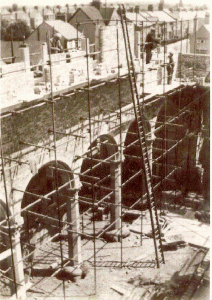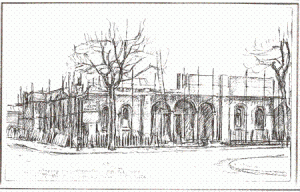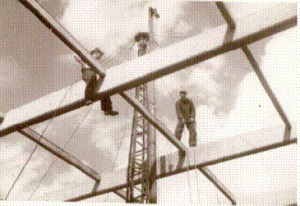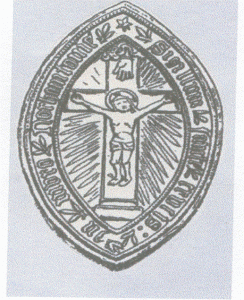The Dream Fulfilled
The text of the history section is from the Parish History, written by Des Keohane. The printed version is available from the Church for £3.50 and may be requested by post, at extra cost for postage. Any amendments or additions are welcomed – please send by email to Fr Andrew
 The Parish was busily raising a building fund. The temporary church had cost £1 000, exhausting the earlier fund, and then the church and presbytery had been furnished. The Diocese was committed to a permanent St. Gregory’s, but also had many new financial commitments elsewhere. The Parish embarked on a programme of varied fund-raising events—even, as the photograph shows, involving Father Phillips selling fish! Also, a building loan scheme was floated by which individuals lent sums of money, free of interest, for six years. It is testimony to the generosity of the Parish that, whilst raising money for its new church, it also contributed to the cost of the enlargement of the Cathedral.
The Parish was busily raising a building fund. The temporary church had cost £1 000, exhausting the earlier fund, and then the church and presbytery had been furnished. The Diocese was committed to a permanent St. Gregory’s, but also had many new financial commitments elsewhere. The Parish embarked on a programme of varied fund-raising events—even, as the photograph shows, involving Father Phillips selling fish! Also, a building loan scheme was floated by which individuals lent sums of money, free of interest, for six years. It is testimony to the generosity of the Parish that, whilst raising money for its new church, it also contributed to the cost of the enlargement of the Cathedral.
A significant step forward took place in May 1949 when the Bishop authorised Father Phillips to contact an architect. He consulted Gregory Webb, an expert in church design, and Sebastian Comper FRIBA was chosen. Comper had undertaken work with his father, Sir Ninian, at Downside Abbey, where Father Phillips had many contacts, and this probably helped in the choice. From the contemporary report, it seems that the prevailing opinion was that modern designs were to be avoided, and Comper certainly suited that requirement. He deplored “modernists always seeking something new.” The Bishop readily concurred with the choice, and he must have been pleased with it for Comper later designed several other churches in the Diocese, including St. Aidan’s at Kingsthorpe. The architect had no easy task. Father Phillips was an exacting client (it was observed that there were two architects!), the post-war shortage of building materials influenced design choices, and all plans were subject to the careful scrutiny of the Diocesan Finance Board. The style of building which eventually emerged, as the preferred option, was the simple Roman Basilican style which we see today. In 1950 Father Phillips had been to Italy and visited the Church of S. Francesco in Ravenna built in that style. He liked it, and it is on the design of that church that the architect based his plans. There is further information on Sebastian Comper for those readers who would like to know more.


The first design for the church (see above) envisaged a much larger building occupying the whole of the present site, including the car park area. The problem of cost ensured that these plans were revised several times before a reduced and simpler design was finally accepted. The length of the church was reduced substantially. The reduction might be more meaningful if we say that the five existing freestanding pillars in the church would have been nine. The exterior frontage was simplified without the steeple and bell, the sanctuary was reduced in size, the pulpit omitted, and the planned sacristy to the left of the nave also omitted. Neither the architect nor Father Phillips saw the reduced design as permanent: In listing his own works, Comper always referred to St. Gregory’s, as it was built, as Part 1. The intention to build on can be seen today if one stands in the Car Park and looks at the rear wall of the Sanctuary, where the different nature of the brickwork is clear evidence. Another economy was to forgo the plastering of the internal walls. Nevertheless, the final plan promised a fine church and costs were agreed. However, the problem of post-war building restrictions remained. Supplication to Our Lady once more bore fruit, and thankfully a license was obtained for building to commence in July 1952. Construction was again undertaken by Weston & Underwood.
 On July 5 a large number of parishioners gathered to watch the cutting of the first turf. The oldest active parishioner, Mr. G P Sharp, undertook the task. Mr. Sharp, as a boy, had known Bishop Riddell who had first planned a church for the east of the town, and by coincidence, he lived in Whitworth Road adjacent to the original site.
On July 5 a large number of parishioners gathered to watch the cutting of the first turf. The oldest active parishioner, Mr. G P Sharp, undertook the task. Mr. Sharp, as a boy, had known Bishop Riddell who had first planned a church for the east of the town, and by coincidence, he lived in Whitworth Road adjacent to the original site.
 Another large gathering on the evening of 28 August 1952 saw Bishop Leo Parker lay the Foundation Stone. At the ceremony were Abbot Butler from Downside, the future Bishop Charles Grant (eighth Bishop of Northampton 1967—1982), Father Anthony Hulme who had said Mass in Abington in the 1940s, Fathers Maunsell, Chapman and Jenkinson, all previous curates at St. Gregory’s, and many other clergy of the Diocese. Mr. Billy Weston, and his foreman Mr. Frank Flavell are seen in the photograph on the left watching the stone into place. Today a commemorative tablet of the event may be seen set in the north interior wall of the church.
Another large gathering on the evening of 28 August 1952 saw Bishop Leo Parker lay the Foundation Stone. At the ceremony were Abbot Butler from Downside, the future Bishop Charles Grant (eighth Bishop of Northampton 1967—1982), Father Anthony Hulme who had said Mass in Abington in the 1940s, Fathers Maunsell, Chapman and Jenkinson, all previous curates at St. Gregory’s, and many other clergy of the Diocese. Mr. Billy Weston, and his foreman Mr. Frank Flavell are seen in the photograph on the left watching the stone into place. Today a commemorative tablet of the event may be seen set in the north interior wall of the church.
 In this photograph of the laying of the foundation stone shows the tripod crane over the place where the foundation stone lays, the outline of the foundations of the apse, and a cross erected over there the High Altar was to stand. The temporary church can be seen in the background.
In this photograph of the laying of the foundation stone shows the tripod crane over the place where the foundation stone lays, the outline of the foundations of the apse, and a cross erected over there the High Altar was to stand. The temporary church can be seen in the background.
Building now proceeded and continued over the next eighteen months. Building operations in the 1950s were significantly different from those of today, and the photographs below reflect this. You may note the long ladders and the absence of hard hats. Concrete roof beams were being used and the lifting of them was done by a hoist, and not by the ubiquitous crane hired in on modern building sites. St. Gregory’s was a major project in the town and it was completed to a high standard.






The building was underway, but the cost would have to be met. The estimated cost was £16 000, of which £8 000 had been already raised, and a 15 year mortgage at 5% was entered into. Building estimates rarely prove accurate, and with fees and furnishing the final cost was approximately £22 700, which in today’s (2008) prices would be about £450 000.
It is not surprising, therefore, that parishioners attending the laying of the Foundation Stone were given envelopes and asked to process past the stone and place a donation upon it! Fund raising would remain a feature of Parish life.
A fortuitous event had taken place in 1951 when 22 Park Avenue North, next to the site, came on the market. It was quietly bought to avoid any price hike, and it became our Presbytery so enabling the priests to move from No.55.
As the building work progressed, a material link, symbolic of a spiritual link, with the medieval church of St. Gregory was incorporated. The old church had long disappeared, any remaining structure having been used and altered to house the Town & County Grammar School (now the School for Boys) in its early days, and by the 1950s it was used by Mr Hamp as a furniture depository. Father Phillips secured the owner’s permission to crawl in the cellars and retrieve some stones from the foundations of the old church. These stones were placed under the Blessed Sacrament altar in the new St. Gregory’s.
 To this day the Parish maintains a visual link with the old church by reproducing the seal of the Fraternity of the Rood-in-the-Wall in special commemorations. Also, during the building of the church, Father Phillips had embedded in the wall of the outer porch a medal he had personally received from Pope Pius XII. It lies behind the papal tiara and crossed keys above the main doors.
To this day the Parish maintains a visual link with the old church by reproducing the seal of the Fraternity of the Rood-in-the-Wall in special commemorations. Also, during the building of the church, Father Phillips had embedded in the wall of the outer porch a medal he had personally received from Pope Pius XII. It lies behind the papal tiara and crossed keys above the main doors.
As the final stages of the building were reached the large crucifix facing Park Avenue North was erected. It stood as a public declaration of the Christian Faith and thus it stands today. Over the years it has also become a distinctive identification of St. Gregory’s, “the church with the cross,” The origin of this Crucifix is not clear. It may well have been a gift to the new church.
The Official Opening of the new church took place on 11th February 1954. It was the Feast of Our Lady of Lourdes, and was specifically chosen by Father Phillips, as befitting his strong devotion to the Blessed Virgin and his attachment to Lourdes. The ceremony was conducted by Bishop Leo Parker, who was that day celebrating the fifteenth anniversary of his consecration as a bishop. Also present were Dr Joseph Rudderham, Bishop of Clifton, and Dom Christopher Butler, Abbot of Downside. Bishop Rudderham had been Administrator of Northampton Cathedral, before his elevation in 1949, and was familiar with the St. Gregory development. Abbot Butler, later Auxiliary Bishop in Westminster and well-known in his day as a contributor to television discussion programmes, was a Downside friend of Father Phillips. The Mayor and Mayoress of Northampton, Alderman and Mrs W A Pickering, also attended with officers of the Borough Council and local dignitaries, and a large number of parishioners. All processed from the temporary church and filled the new church to capacity. After blessing the church, Bishop Leo Parker celebrated Pontifical High Mass. A Celebratory Lunch followed in the Abington Parochial Rooms. There was much supportive coverage of the opening in the local press.
It was over 50 years since Bishop Riddell had first planned a church on the eastern side of the town; it was nearly 30 years since the Park Avenue site had been purchased by Bishop Cary-Elwes: and now the Catholic people of Abington and the bordering areas had their own parish church. It was a cause for celebration and satisfaction
